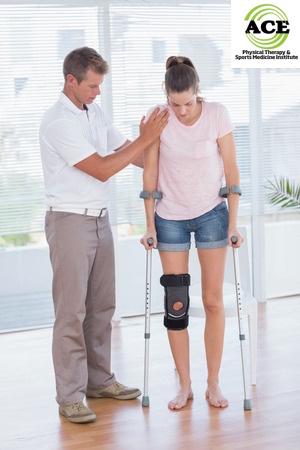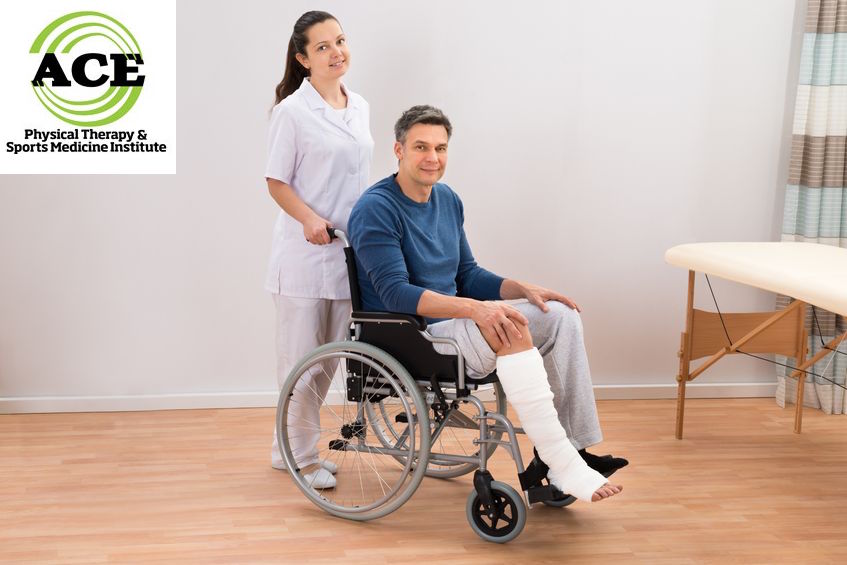WEIGHT BEARING STATUS AND PHYSICAL THERAPY
Weight Bearing Status and Physical Therapy
by ACE Physical Therapy and Sports Medicine Institute
Tid Bits of Info.
- The Physical Therapist can assist in determining a percentage of body weight by having the patient stand on a scale.
- TT and TD gait are transitional forms of gait designed to put a percentage of the body weight on the involved limb and stimulate more healing.
- An assistive device needs to be used in NWB and PWB gait.
- A single assistive device (i.e. cane, one crutch) should be used with the opposite upper extremity.
- Seek the advice of a Physical Therapist to help determine the weight bearing status .
To simply walk across a room normally involves carrying our full body weight in each leg, in alternating rhythm. This is known as full weight bearing status. After an injury or a surgical repair, an orthopaedic Physical Therapist may order a period of partial weight bearing (PWB) status or even a non-weight bearing status (NWB) to facilitate healing for a particular tissue type (soft tissue, cartilage or bone). In many instances, there is a need for diagnostic testing such as x-rays or MRI and CT scans to determine how well the injured or repaired tissue is healing and when to increase the weight bearing status.
During recovery, a patient may move from non-weight bearing to partial weight bearing and eventually to full weight bearing. Certain conditions require a complete NWB status for a period of time to allow the tissue to begin the healing process. Eventually, it becomes advantageous to add some weight to the injured or repaired area to help stimulate more healing. During the final phase, FWB enables the injured person to return to their normal pre-injury functional levels.
Non-weight bearing status
Health professionals prescribe NWB for the acute, severely injured or during the newly repaired time period. Almost any tissue type can heal if given enough time and stimulus. When cartilage and bone are repaired, they will heal but it takes a long time: entire healing can take several weeks to several months. During this healing time, the injured person can severely inhibit or even stop the healing process if they put weight on the repaired tissue too soon.
Broken bones will naturally begin to heal. Some may require surgical repair, but all will normally begin the healing process. A cast can realign broken pieces in proper anatomical position, so the bones will begin healing properly. During this healing phase, the NWB status allows the bones to remain properly aligned.
Even though the patient is NWB, there are plenty of Physical Therapy treatments that can take place. The muscle structure surrounding the injury or repaired site can be stimulated and re-educated to function. The muscles of the core and upper extremities should be stimulated to help prevent total deconditioning to occur. The joints near the injury site or along the kinetic chain of the injury site (i.e. if the ankle is broken the knee and hip are part of the kinetic chain) can be stretched and strengthened to avoid excess muscle loss and range of motion.
Partial Weight Bearing Status
 When patients transition through the PWB phase, they require the use of an assistive device. Now the patient is instructed to put some portion of the body weight on the injured lower extremity. The healthcare professional determines the amount of weight that can be placed on the involved limb via special tests, X-rays, MRIs or CT scans, and the stage of healing. The patient will be told to place a percentage of body weight on the involved lower extremity to enhance the healing process. Different tissue types heal at different rates of speed, but all of them will heal more quickly and completely if a portion of the body weight is placed on the involved limb. The body and the healing tissue will respond to the added weight by producing more cells and eventually completing the healing process.
When patients transition through the PWB phase, they require the use of an assistive device. Now the patient is instructed to put some portion of the body weight on the injured lower extremity. The healthcare professional determines the amount of weight that can be placed on the involved limb via special tests, X-rays, MRIs or CT scans, and the stage of healing. The patient will be told to place a percentage of body weight on the involved lower extremity to enhance the healing process. Different tissue types heal at different rates of speed, but all of them will heal more quickly and completely if a portion of the body weight is placed on the involved limb. The body and the healing tissue will respond to the added weight by producing more cells and eventually completing the healing process.
The patient will be instructed to be PWB in the form of “toe touch” (TT) or “touch- down”(TD) gait. The “toe touch” gait is when the patient places the toes only on the ground and uses the assistive device to “unload” the remaining body weight. “Touch-down” gait is when the patient places the entire foot on the ground, but uses an assistive device to “unload” the remaining body weight. The goal of PWB is to transition the patient to full weight bearing and in the process re-educate the involved limb to accept and withstand the forces associated with full weight bearing. The patient’s rehabilitation program is progressed during this transitional phase of weight bearing to include a host of exercises that have the foot on the ground and are known collectively as “closed chain” exercises.
Full weight bearing status
Eventually the patient is instructed to put full body weight on the involved limb. The patient cannot regain full function until reaching the FWB phase. The time it takes to reach FWB is determined by healthcare professional and the special tests. The patient may take several days to weeks to transition to FWB and may have to wear a protective brace of some sort. The goal is to discard the assistive device and walk as normally as possible. Regaining the ability to FWB will enable patients to return to all of their activities.
The different forms of weight bearing are used to protect the involved lower extremity during the healing process. The transition from NWB to FWB can be lengthy, but if done properly the patient will return to full functional capability and experience a minimal amount of discomfort during the transition.
Read more articles on our main website blog at: ACE-pt.org/blog
Vist our main website at www.ACE-pt.org

